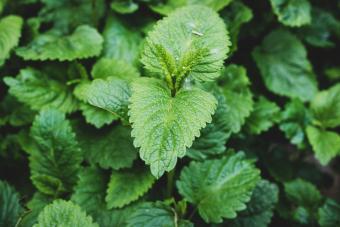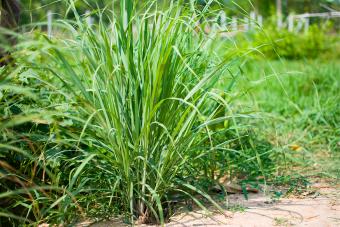
If tea and gardening are two of your favorite things, maybe it's time to combine your passions. Growing a tea garden is a great way to exercise your green thumb, especially if you enjoy drinking tea and like the idea of making your own botanical blends. Get started by planting some popular tea garden plants and a few berries and herbs that make tasty tea.
Calendula (Pot Marigold)

Calendula (Calendula officinalis), also called pot marigold, likes cool conditions, so it grows best during spring and fall. It's a drought-tolerant plant that'll grow and bloom in full sun (as long as it's not too hot) or in partial shade. Both calendula leaves and flowers are edible. The leaves impart bitter and astringent flavors, while the flowers impart mild, herbal, and peppery notes with a hint of bitterness.
Echinacea (Purple Cone Flower)

If you're looking to make your own immunity-boosting tea, echinacea (Echinacea purpurea) is a perfect choice. Echinacea is drought-tolerant perennial in USDA Zones 3-9. It likes full sun or partial shade. The leaf, flower, and root are all edible and can be used in tea. It has a strong, earthy, floral flavor that provides a tongue-tingling sensation. It's helpful to combine the strong flavors of echinacea with an herb like mint or basil to temper them.
German Chamomile

For tea, grow German chamomile (Matricaria chamomilla) rather than the Roman variety, which is a groundcover. German chamomile is drought tolerant and likes mild weather. It grows in partial shade or full sun. Both the leaves and flowers of German chamomile are edible, so you can use either or both in the tea. German chamomile tastes grassy, and the flowers are slightly floral with a light apple flavor.
Roselle (Hibiscus)

Roselle (Hibiscus sabdariffa) is commonly used to make hibiscus tea. Roselle is a shrub that can reach eight feet tall with a spread of about four feet. It likes heat, lots of direct sunlight, and a lot of water. The flowers, leaves, and seeds are all edible, but the calyx is what's used in tea. Hibiscus has a tart flavor similar to cranberry, and it imparts a vibrant red color to your tea.
Many other types of hibiscus are not safe to eat or to make tea.
English Lavender

English lavender (Lavandula angustifolia) makes delicious tea. Lavender grows best in full sun. It prefers to stay pretty dry, so it is drought tolerant and needs well-draining soil. Grow it in the ground or in pots. Both the leaves and the flowers (stripped from the stem) are edible, so you can use either in tea. The flowers have a delicate floral flavor and aroma with a slight peppery note, while the leaves are stronger with more bitterness.
Roses

Roses (Rosa rubiginosa) are wonderful tea garden plants. You can use their seed pods (hips) to make tea, as well as their petals and buds. Roses do best in full sun; explore our rose growing guide for more information. Rose hips have a flavor similar to hibiscus or tangy cranberry. Rose petals are floral and taste a lot like they smell.
Black Tea

If you're in USDA Zone 8 or higher and have room for a plant that's over 10 feet tall and up to eight feet wide, you can grow your own black tea (Camellia sinensis) plant. This shrub will grow in full sun or partial shade. You use the leaves of the plant to make tea. Black tea imparts strong, astringent, malty flavors.
Mint

Mint (Mentha) leaves make a tasty tea believed to aid in digestion. Mint is so easy to grow that it's often described as aggressive or invasive. With that in mind, it's better to plant mint in a container rather than in the ground. You can use both the leaves and stems to make tea. Mint has a powerfully strong flavor and aroma, so in a tea blend you may want to add just a little, and then add more as needed so it doesn't overwhelm more delicately flavored plants.
Lemon Balm

Lemon balm (Melissa officinalis) is in the same family as mint, and it grows just as aggressively, so it's better to plant it in containers rather than in the ground. Use its leaves to make lemony mint tea. It has a bright, citrusy flavor with just a hint of mint.
Lemongrass

If you like lemony tea without the flavor of mint, add lemongrass (Cymbopogon citratus) to your tea garden. This tropical plant likes full sun and hot weather. It grows in large clumps, like an ornamental grass. Use the stalks of lemongrass to add to tea. It has a mild citrus flavor with slight ginger notes.
Basil

Basil (Ocimum basilicum) is a leafy herb primarily used in cooking. It's an annual that grows outdoors in summer or indoors year-round. Steep basil leaves in water to make delicious tea. Feel free to use multiple varieties. Use basil leaves and stems for your tea. The flavor is a combination of citrus, mint, and pepper with slightly sweet notes.
Sign up for our newsletter featuring all the latest stories and products we love.
Ginger

Ginger (Zingiber officinale) is a rhizome commonly used in cooking that makes terrific tea. Grow ginger outside when it's warm or grow it indoors. To make ginger tea, steep sliced or shredded ginger root or ginger leaves in water. The tea with have a mild peppery bite with spicy, warm citrus notes.
Raspberry

People primarily grow raspberry (Rubus idaeus) plants for berries, but it's easy to make great tea with dried leaves of raspberry plants. Raspberries are bushes that are hardy in USDA Zones 3-10 (depending on variety). Raspberry leaves taste similar to black tea.
Strawberry

Dried strawberry (Fragaria) leaves work just as well for tea as raspberry leaves. Strawberries are easy-care, low-growing plants mostly grown for fruit. They don't produce berries all year, but the plants do survive mild winters. Strawberry leaves are mild with slight fruit, grass, and bitter notes.
Grow Your Own Tea Garden

It's easy to get started growing plants to make your own tea. Start with any of the plants listed here that grow in your climate, or pick a few to grow indoors in containers. It's easier to grow the leafy plants indoors than the ones that flower, as they don't require as much bright light to be productive. Once you get comfortable, check the ingredients of your favorite tea blends to get inspired with ideas for other plants to add to your tea garden.







